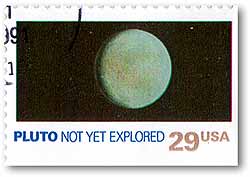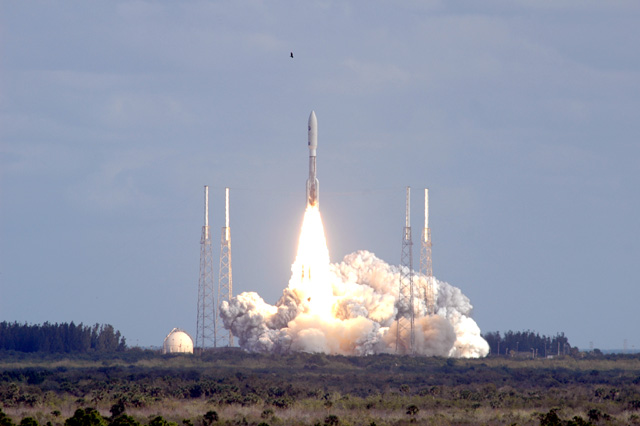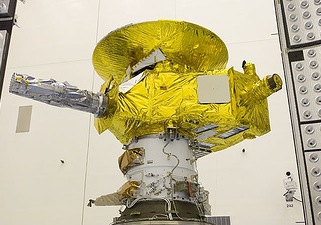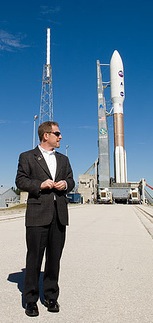Today is New Horizon's day in the sun. Which is good, because out beyond Saturn there is less and less Sun to go around. Today we focus on a biography and an explanation of this one little project and its journey to flight and why, exactly, I choose it above and beyond all other comers for the title of "favorite space probe."
I don't want to start by drowning this whole blog in a sea of specifications and technical data -- if you really care about how many milliradians the ifov of the LORRI imager is, look it up. Rather I'd like to start by recounting a rejected name from the day's of New Horizon's development. Apparently naming the damn thing was proving quite a challenge. As I've heard it told, it was almost a case of analysis paralysis, and some interesting candidates were circulating around, mostly tongue-in-cheek. One that actually made a big impression on me was FARR: Finally A Return to Reconnaissance.
Ok, no space probe is ever going to have a name beginning with "Finally" and the crankiness it implies. But there is a message in that name -- for decades we've been going back to revisit worlds already explored to gather more data. Missions have grown more focused on particular themes ("Follow the Water!") or areas of understanding. The approach reminds me a bit of what Hollywood has been doing of late -- remakes, sequels, and adaptations. Don't take the risk (the studios and executive producers seem to think) of going into completely new territory because you might gaffe it entirely and end up with an expensive flop. Instead, pick a relatively well known subject with a somewhat predictable audience and go for that.
There's some legitimacy. I'll go see Ocean's 14 or whatever they are up to now. At least I'll rent the video. My daughter will definitely go see Shreck the 4th. But you know, that first Matrix movie could have been one hell of a flop. And with film budgets what they are now, that thinking is going to force a real drive to conservatism. Plan (1) says you could make $200 million or loose $100 million. Plan (2) says you are almost guaranteed to make $150 million. Bottom line choices make that easy. Balls-out risk takers are rare, now a days.
Spaceflight's gotten the same way, to an extent. We're revisiting worlds we know. We're looking at the details, following exploratory themes. This is great science, and a lot is learned from it. There is, I think, some extra conservatism even within this overall trend to avoid looking directly at the big issues (exobiology is what I'm talking about here) because as long as the big questions are unanswered there is still a chance of flying more missions and learnign plenty about the interesting but undramatic other stuff.
Don't get me wrong. I love this thorough understanding of our neighborhood. I'm more of a deep-space astrophysics guy myself, but Titan, comets, Venus, Mars, Jupiter, Io, all of 'em are fascinating places. And I'm certinly not a fan of the overly-cowboy manned spaceflight program promoted under the Bush administration. But that's another issue.
I was raised, however, on the pioneering flights of the Pioneers and Voyagers. I remember staying up until unusual (for a nine year old) hours to watch episodes of Nova or other specials on PBS (channel six!) as the probes encountered Jupiter, Saturn, Uranus, and finally Neptune. I remember that feeling of seeing new worlds and new moons for the first time. The Saturnian system (apparently it is technically accurate to call it Kronian but unnecessarily arrogant to do so) was the most vivid memory, because it really was a special event for a precocious 9 year old with a space infatuation. The rings, beautiful and so much more complex than ever imagined, moons, moons, and more moons, from shrouded and active Titan to icy
The robotic engineers at the Jet Propulsion Laboratory were my idols, and the planetary scientists gathering and interpreting the results that these probes brought back filled my imagination the way the tales of Lewis and Clark filled the imagination of boys generations ago. But with that one titanic act of exploration, that once in a zillion chance alignment of the great gas giant and ice giant planets, it was done. We'd been everywhere. It was like the scene in The Truman Show where young Truman tells his class he wants to be an explorer and the teacher quashes his dreams by pulling down a world map and saying (I paraphrase) "It's all been explored!"
From this point on, Lewis and Clark could rest at home, take it easy. Follow-on explorers would set about to filling in the details, trading with the natives, exploiting whatever resources they could find, and finally building shopping malls. No wonder Lewis killed himself in the end.

None flew.
Through the fast moving space policy shifts of Reagan-Bush-Clinton-Bush (and a couple of dramatic economic cycles thrown in for the bargain), Pluto missions were on and off and on again in a half dozen different variations. International missions launched by Russian Proton boosters...ultralight weight "twin" missions launched by Titan IV boosters to catch both sides of the planet...and then death. Complete and total demise of the whole Pluto mission thing.
In the meantime the planet itself kept getting more interesting. It had an atmosphere. It had a moon. It might have meteorologic or prebiotic processes. We mapped some of its surface features (crudely). Suddenly this pinpoint of light in the distance was a solid world with features of, well, a real planet.
Soon the letters started coming in. Alan Stern, long time Plutophile (read his book!) and a few earnest space enthusiasts kept the dream alive and via the newest tool for space science outreach organized an Internet campaign to revive a Pluto mission. It worked. Congressional fiat inserted (and mandated) funding for a competitively selected Pluto mission. The folks at the Johns Hopkins Applied Physics Lab put forward a proposal -- headed by Stern. JPL put forward a proposal of their own, but I suspect it was mostly just to keep the APL honest. This was Stern's baby, and everyone knew it.
He finally settled on a name -- New Horizons -- and so the mockingly appropriate FARR was retired to the mists of history and blogging. New Horizons works -- I grant them that -- and is a proper name and not just an acronym. But I miss something of the spirit of FARR.
It took a few years -- and a few near fatal setbacks -- to get the thing on the way. A security scare shut down processing of the Plutonium fuel pellets necessary to keep NH warm and powered. Scrambling managed to get enough Plutonium together to ensure a successful mission. Anti-nuke protesters made desultory threats at preventing the launch -- but other than a few ill-informed crazies and a pacifist grandmother or two, the public failed to mobilize to their cause. The Boeing strike season meant that the workers who would have prepared the 3rd stage motor were walking the picket lines so salaried managers pitched in to ready the motor -- and the protests of the strikers went generally unheard except by the anti-nuke crazies. Winds delayed the first launch attempt. A freakish power outage prevented day two. And clouds almost shut down day three -- until luck and a hole in the weather resulted in one of the most spectacular unmanned launches I've ever seen.
Aviation Week's wonderful article tells the details of the complexity of supporting this little spacecraft's journey. I find the final part of the article -- the throttling profile of the RD-180 first stage engine -- to be particularly telling. Most flights bang the throttle to the stops until the very end when you might start to go easy to avoid pulling parts off. But this flight pushed the profile optimization for every meter per second of delta-V it could generate.
Roll back to my Why'd We Put the Rockets There post for a video of the NH launch in all of its glory. More thrust than any other current US launcher save the Shuttle. Off the pad like a bat out of hell and from then on, no looking back.

I'll save the "gee whiz" statistics and detailed instrument descriptions for the team's fantastic web presence. In a nutshell the probe is a piano attached to a satellite dish -- a compact body designed to keep heat in and minimize mass attached to the largest dish antenna cheaply available. The radioisotope generator (home of the pesky Plutonium) sticks off to one side to keep its temperature manageable. Gold foil provides much needed insulation so that the waste heat from the electronics and the RTG can keep the vital systems warm, including preventing the propulsion systems propellent from freezing.
The science instruments are like the eyes of a lemur, oversize and blinded by daylight, carefully tuned instead to the dark distance of Pluto. A telephoto camera, a multicolor camera, and infrared and ultraviolet spectrometers comprise the primary remote sensing suite. Three instruments record the nature and intensity of dust and heavy and light charged particles as the craft drifts by Jupiter, through deep space and, later, through the Pluto system. Finally the onboard radios play a part by enabling careful trajectory tracking that reveals in detail the mass of objects in the Pluto system and by a clever bit of passive microwave radiometry that helps determine surface temperature.


Approaching their encounter with Jupiter, the official science team was busy doing official science -- planning the aspects of the Jupiter swingby that would generate the most compelling scientific data return. Several enthusiasts on the UMSF boards, however, used trajectory information provided by the NH team to simulate in great detail the probe's journey through the complex Jovian system. Using these simulations, they were able to identify a number of "Kodak Moments" as space probe types call them -- the beauty shots of crescent moons, ring systems, and extraterrestrial volcanic eruptions that actually make it in to the newspaper.
Since the science team actually had more spacecraft resources than they had time to plan for, they accepted these amateur contributions and, instead of sneering at the part-timers, added the suggestions in to the flyby mission plan. And you can bet which images appeared on the newspaper covers -- not the dull-but-scientific ones, but the glamour shots that those of us out on the Internet came up with.
The New Horizons team has also done all the standard things -- a CD carrying names of supporters who registered on the Internet is mounted on the probe (and you can bet that my name -- and the names of those closest to me -- are on there). Podcasts, email updates, and well maintained websites too. And some of the most easily available detailed documentation of a current vehicle I've ever found. They've got the now obligatory Twitter presence (NewHorizons2015, if you want to get the updates) which is pretty chatty right now since the team is working one of the annual checkout periods that will lie between long sessions of hibernation.
For these efforts and others, Stern's gone on to become something of a hero (and very occasional email correspondent) of mine, not least for his brief stint as head of NASA's space science division -- a stint that was oddly parallel to my own stint with my most recent employer in timing and apparent motivations for departure. But now he's back at the APL, flying space probes when he can and getting instruments of his aboard nearly a half dozen other flights. NH is the largest ever PI (Primary Investigator -- as opposed to a NASA laboratory) managed space project NASA's ever flown -- you libertarians can think of PI managed missions as sort of like the charter schools of space exploration. Through blunt perseverance, clever engineering, shrewd campaigning, and tight management, it is bringing a little bit of the mystery back in to space exploration.
And out there, a billion kilometers away and just beyond the orbit of Saturn, finally flies the return to reconnaissance.
By the way, if you want to see some absolutely spectacular photography of not just the New Horizons launch, but several others as well, check out launchphotography.com.
No comments:
Post a Comment